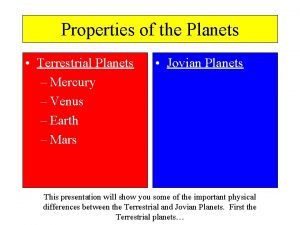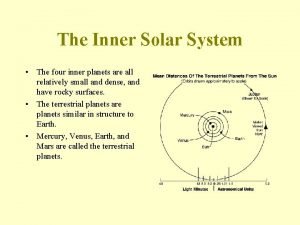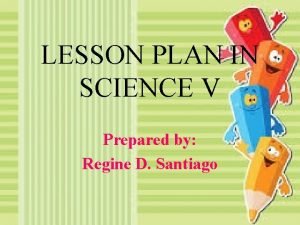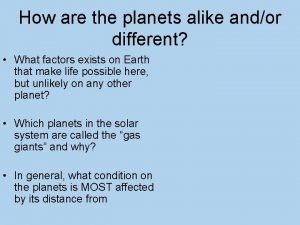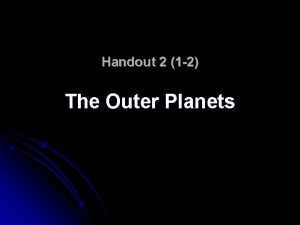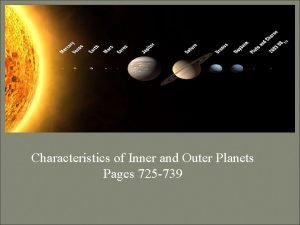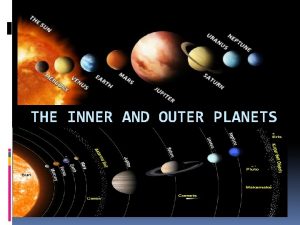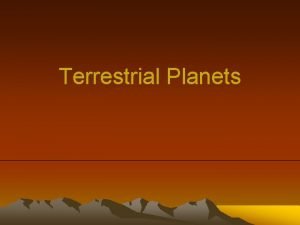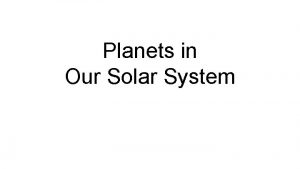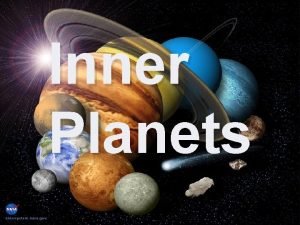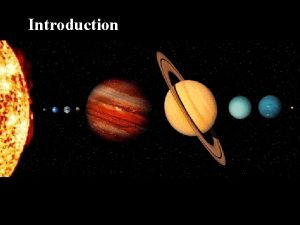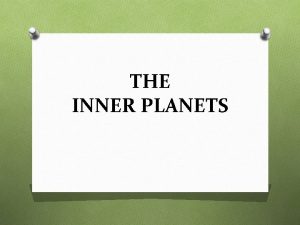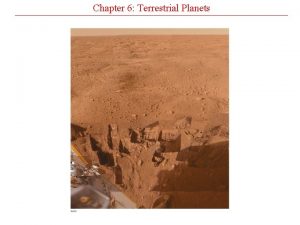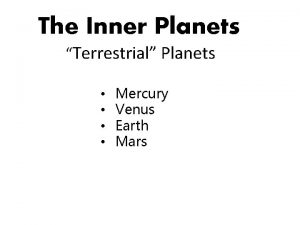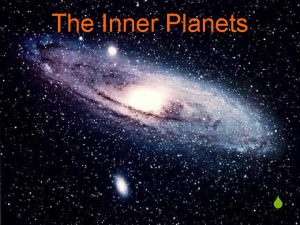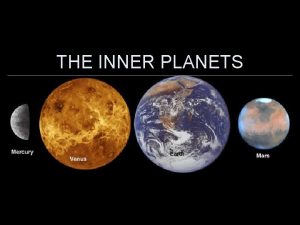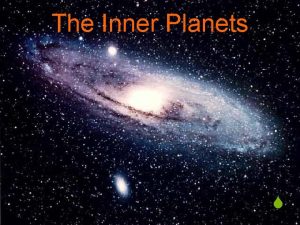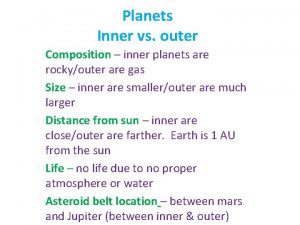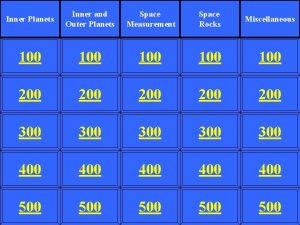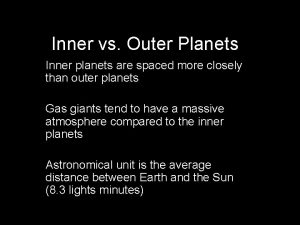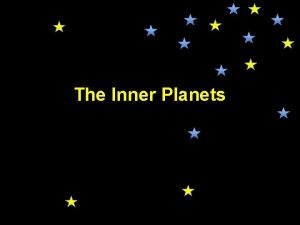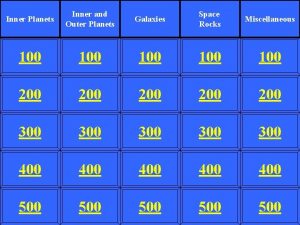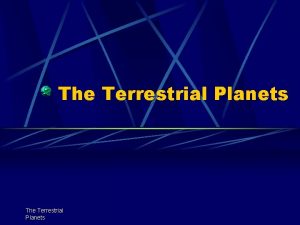Introduction Inner Terrestrial Planets The 8 Planets Planets




















- Slides: 20

Introduction Inner Terrestrial Planets

The 8 Planets • Planets are characterized by composition, density, and distance from the sun. • The inner planets are smaller and rocky (example = Earth). • The outer planets are large and made of gases (example = Jupiter).

Planet Earth

• Environmental Science - is the study of the infinite number of interactions between humans and the world in which we live. This includes the living and non-living factors As Earth’s human population continues to grow, as technology advances and human needs and wants increase, our impacts on the world become more widespread and severe, despite improvement in some areas.

• Ecology – an interdisciplinary that involves the study of how living things interact with each other and with their nonliving environment.

What’s so special about Earth? • Earth supports life due to the presence of liquid water. • Earth maintains a steady surface temperature due to the heat being absorbed in the summer and released in the winter through water. • Many more unique qualities

Is the sun important? • Supports life on Earth by transmitting energy to us in the form of light • Light travels to Earth in the form of waves


Why are plants green? Part II

Environment and society How has our effect on the environment changed over time?

Environment and society Hunter Gatherer – small migrating groups who obtained their food and resources by collecting wild plants and hunting wild animals. Affect on their environment: -contributed to the loss of some large mammals. -relative to other human societies their impact was small.

Environment and society Agricultural and the 1 st Agriculture Revolution – the domestication of plants and animals led to permanent settlements and higher potential populations. Affect on their environment: - we domesticated plants and animals to better fit our needs and in turn caused them to evolve. - altered natural biomes and transformed many into farm land. -impact on the environment increased from the hunter gatherer societies

Environment and society Industrial –when we shifted energy sources. From animal / human muscle and water power to fossil fuels. Affect on their environment: - greatly increased our impact on global environments - habitat loss - pollution

Environment and society On the Positive Side: Resource availability has increased dramatically Improvements in medicine, healthcare and lifespan. Massive improvements in communication, sanitation and quality of life.

Population Effects Population: 7. 5 Billion People The exponential growth of human population is a core cause of the environmental issues that we have today. The higher the population the greater the various impacts we as humans have on the planet – Ecological Footprint

Modern Day Environmental Issues: Resource Depletion Pollution Loss of Biodiversity

Environment and Economics: Economic Forces influence how we use our resources and how the degree to which we effect the Earth Supply and Demand – as demand for the resource increases, the value increases as well. This can lead to the exploitation of the resource. Costs and Benefits – analysis that balances the cost of an action verses the benefit expected from it. . This can alter decisions that will have effects on the environment. Risk Assessment – a part of a cost benefit analysis that estimates the risk of an undesirable outcome

Environment and Economics

Sustainability: Sustainability Is the condition that the human race can meet their needs and maintain a similar standard of living that we presently have while insuring our ability to survive indefinitely into the future.

An ecosystem service is the role that ecosystems play in creating a healthful environment for humans. • This grouped ecosystem services into four broad categories: – Provisioning - such as the production of food and water – Regulating - such as the control of climate and disease – Supporting - such as nutrient cycles and crop pollination – Cultural - such as spiritual and recreational benefits.
 Inner planets and outer planets
Inner planets and outer planets Why are jovian planets bigger than terrestrial
Why are jovian planets bigger than terrestrial Inner defender and inner guide examples
Inner defender and inner guide examples What separates the inner and outer planets
What separates the inner and outer planets What is each planet made of
What is each planet made of Surface of terrestrial planets
Surface of terrestrial planets Characteristic of mars
Characteristic of mars Properties of terrestrial planets
Properties of terrestrial planets Inner critic and inner defender
Inner critic and inner defender The four inner planets
The four inner planets Inner outer planets venn diagram
Inner outer planets venn diagram Planet andor
Planet andor Matching planet rings
Matching planet rings Uranus distance from sun
Uranus distance from sun What separates the inner and outer planets
What separates the inner and outer planets My very excited mother planets
My very excited mother planets Smallest terrestrial planet
Smallest terrestrial planet Inner planets
Inner planets Kidsastronomy.com/solar system
Kidsastronomy.com/solar system Inner planets
Inner planets What are the four outer planets called
What are the four outer planets called







